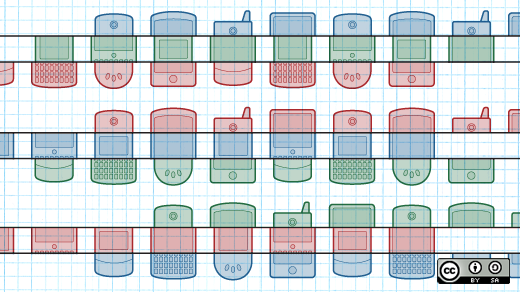Multiple books in the Open Organization series discuss the many ways new communication technologies are changing the nature of both work and management. I've seen these changes firsthand during my nearly three decades working for Japanese corporations. Over time, I've been able to classify and characterize some of the impacts these technologies—particularly new telecommunication technologies and social media—are having on daily life in many organizations. And in April 2016, I shared those observations in an article called How new communication technologies are affecting peer-to-peer engagement.
But a lot can change in a little under four years.
The Open Organization Ambassadors have learned a great deal about the ways open principles are impacting organizational practices. In particular, we've developed an Open Organization Definition that specifies the five principles that distinguish open organizations from other types of organization—namely, more transparency, more inclusivity, greater adaptability, deeper collaboration and a sense of purpose teams/community. I've also delivered a presentation on this topic several times since 2016 and learned new insights along the way. So I'd like to update this article with a few comments that reflect those findings. And then, in a follow-up article, I'd like to offer readers some guidelines on how they can determine their organization's level of comfort with communication technology and use it to increase their success relative to industry competitors.
Simply put: New communication technologies are affecting the way peer-to-peer decision-making practices function in organizations today. And that's affecting several important organizational dimensions: peers' transparency with each other when making decisions, the sense of inclusivity between members in decisions-making activities, their adaptability when situations change, their ability to collaborate with more individuals in the decision-making process, and their ability to build teams, groups, and communities to decide how to achieve their goals.
Four approaches to communication technology
In Japan, I see companies that heavily promote today's communication technologies, as well as some that avoid them. Imagine four types of companies currently making use of today's communication technologies as they compete with other firms. These technologies are key, because they influence the environment in which certain peer-to-peer communities must work. It affects their collaboration and transparency with each other, their inclusivity with members they couldn't consider before because of location, their adaptability in a crisis, and their ability to build a sense of community among their members. This, in turn, affects members' enthusiasm, desire, and engagement—so investment and utilization are critical considerations. In fact, we can actually chart the four types of technology-adopters according to those two variables: investment and utilization.
Some companies are underinvested in new communication technologies, considering their needs and the relatively lower costs of these technologies today. And what they do have, they're not using to capacity. I call these companies communication technology "slow movers" (low investment/low utilization). Others buy whatever is available at any cost, but don't fully put what they've purchased to full use. I call these communication technology "fashion followers" (high investment/low utilization). Still other companies invest in the very minimum amount of communication technology, but what they do have they use to full capacity. I call these communication technology "conservative investors" (low investment/high utilization). Lastly, there are some companies that invest heavily in communication technology and work very hard to put it to full use. I call these communication technology "communication superstars" (high investment/high utilization).
These "communication superstars" have the ideal environment for peer-to-peer, front-line discussions and decision making. They have greater collaboration and transparency with each other. They include members on their teams that they wouldn't (or couldn't) consider before because of location. They are more adaptable in a crisis. And they have the ability to build a stronger sense of community among their members. Unfortunately, in Japan, particularly among smaller companies, I'd say more than 70 percent are "slow movers" or "conservative investors." If companies would pay more attention to investing in communication technology, and simultaneously increase their efforts at training staff to use the technology to its full potential, then peer-to-peer, front-line employees could explode with creativity and better leverage all five of the open organization principles I mentioned above.
These technologies affect four aspects of information today: volume, speed, quality, and distribution.
Increased capacity for decision-making (volume)
In "communication superstar" environments, communication technologies can actually increase the amount of information that can be made available quickly. Gone are the days in which only researchers or professors have access to in-depth information. Now, front-line people can obtain volumes of information if they know what they're looking for. With more and greater in-depth information in communication superstar company environments, front-line people working there can have more educated discussions, leading to greater inclusivity and collaboration, which can allow them to make the types of decisions that only top management (supported by consultants and researchers) could have made in the past.
Faster pace of decision-making and execution (speed)
New technologies in these "communication superstar" companies are leading to quicker information acquisition, feedback, and flow between the front-line members in the organizations, even if they are very widely disbursed.
Using the metaphor of adjusting the temperature of water coming out of a faucet, I would describe the effect this way: If you move the handle but the temperature changes very slowly, then finding the temperature you want becomes difficult, because the pace of temperature change is very slow, and differences between settings are difficult to determine. But if you move the handle and water temperature change is more immediate, you'll find that getting the correct temperature is much easier; you're moving quicker and making more rapid adjustments.
The same logic applies to peer-to-peer discussions and feedback. I have a five-minute-to-twenty-four-hour goal when replying to my worldwide customers. That means that if I receive an email from a customer (something that arrives on my desktop computer at home, my desktop computer in the office, or on my mobile phone), I like to reply within five minutes. This really surprises customers, as they're probably still sitting in front of their computer! In the worst case, I try to reply within 24 hours. This gives me a competitive advantage when attempting to get customers to work with me. Front-line, peer-to-peer communities in these "communication superstar" companies can have that same competitive advantage in making quality decisions and executing them faster. The capacity for speedier replies allows us to make more adjustments quicker. It keeps both employees and customers involved, motivated and engaged. They become more transparent with information and include members they hadn't considered before. They can adapt more rapidly when redirection is required. They can collaborate at a more in-depth level and can build tighter, more trusting project communities. Information arriving too slowly can cause people to "turn off" and direct their attention elsewhere. This weakens the passion, dedication, and engagement of the project.
Toward wiser decisions (quality)
Information not only travels more quickly when the business communication channels are adequate, but it's also subjected to more scrutiny through greater group collaboration and inclusivity. People can share second opinions and gather additional empirical data using these technologies. Furthermore, new communication technologies allow employees and managers to deliver data in new ways. With my years in sales training around the world, I've learned that using multiple visual aids, infographics, and so forth have greatly enhanced communication when English language barriers could have impeded it. All this can lead to high levels of peer-to-peer, front-line engagement, as up-to-date status reports can be quickly distributed and easily understood, making everyone more responsive.
Maximal reach (distribution)
Not long ago, teammates had to be physically close to one another and know each other well in order to communicate successfully. That's no longer the case, as communication channels can be developed with people literally all over the world. This has led to greater global inclusivity and collaboration. Good communication is the outcome of developing a trusting relationship. For me, building trust with people I've never met face-to-face has taken a bit longer, but I've done it with modern technology. Developing trust this way has led to great peer-to-peer transparency.
Let me explain. Good communication starts with an initial contact, whether meeting someone in person or virtually (via social media or some telecommunication format). Over some period of time and through several exchanges, a relationship starts to develop, and a level of trust is reached. People evaluate one another's character and integrity, and they also judge each other's competence and skills. With this deepening of trust over time, greater communication and collaboration can evolve. At that point, open and in-depth discussions and transparency on very difficult, complex, and sometimes uncomfortable topics can take place. With the ability to communicate at that level, peer-to-peer discussions and decisions can be made. With today's communication technology, greater information exchange can be made among a group of widely disbursed members leading to an expanded team community. I currently have approximately 20 customers around the world. Some I have never met in person; most I have just met in person once. Being stationed in Japan can make regular get-togethers with Europeans and Americans rather difficult. Fortunately, with today's communication technology, I can find solutions for many problems without physically getting together, as I have built a trusting relationship with them.
Concluding comments
With all the benefits of this "communication superstar" working environment, in open organizations that promote peer-to-peer discussions, decision-making and management, I recommend the other three groups to move in that direction. The "slow movers" more than likely have managerial barriers to open information exchange. They should be convinced of the benefits of a more opened organization and the value of greater information exchange. If they don't improve their communication environment, they may lose their competitive advantage. The "fashion followers" should more carefully study their communication needs and time their investments with their in-company training capacities. The "conservative investors" should study their communication bottlenecks and find the technologies that are available to eliminate them. That's the path to super-stardom.
As I mentioned at the beginning of this article, it's important to determine exactly which of these categories a company falls into with regard to communication technology ["slow movers" (low investment/low utilization), "fashion followers" (high investment/low utilization), "conservative investors" (low investment/high utilization) or "communication superstars" (high investment/high utilization)] against their competitors. Therefore, I would like to address that issue in a future article.






3 Comments